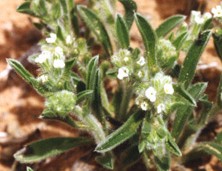Cryptantha crassisepala
Cryptantha crassisepala is a species of flowering plant in the Boraginaceae family, known by the common name thick-sepaled cryptantha. This plant is native to the southwestern United States and parts of Mexico, thriving in desert and other arid environments. It is one of many species in the genus Cryptantha, which are collectively referred to as cat's eyes or popcorn flowers due to their small, white, and sometimes fuzzy flowers that resemble popped kernels of corn.
Description[edit | edit source]
Cryptantha crassisepala is an annual herb that varies in size, often depending on the conditions of its habitat. It typically grows erect, reaching heights of 10 to 50 centimeters. The leaves are linear to narrowly lanceolate, covered in fine hairs, which can give the plant a grayish appearance. The flowers of Cryptantha crassisepala are small, with white corollas that are surrounded by thick, green sepals. These sepals are a distinguishing feature of the species, being thicker and more robust than those of many other Cryptantha species. The flowers are borne in inflorescences that uncoil as the plant matures, revealing the blooms sequentially.
The plant blooms in the spring and early summer, offering a source of nectar to a variety of pollinators, including bees and butterflies. After pollination, it produces small, nutlet fruits that are also characteristic of the Boraginaceae family.
Habitat and Distribution[edit | edit source]
Cryptantha crassisepala is found in the southwestern United States, particularly in states such as Arizona, California, Nevada, and Utah. Its range extends into northern Mexico. It is adapted to a range of arid habitats, from desert flats to rocky hillsides and scrublands. The plant is well-suited to sandy or gravelly soils and is often found in areas with sparse vegetation.
Conservation[edit | edit source]
As of the current knowledge, Cryptantha crassisepala does not face any immediate threats that would warrant its listing as an endangered or vulnerable species. However, like many desert plants, it could be susceptible to the long-term impacts of climate change and habitat destruction. Conservation efforts for desert habitats and biodiversity can indirectly benefit the preservation of this species.
Research and Uses[edit | edit source]
While Cryptantha crassisepala has not been widely studied for specific uses, plants in the Boraginaceae family have been of interest for their medicinal properties and for horticulture. Research into the ecological roles and potential uses of Cryptantha species could reveal more about their importance in desert ecosystems and their potential applications.
See Also[edit | edit source]
Navigation: Wellness - Encyclopedia - Health topics - Disease Index - Drugs - World Directory - Gray's Anatomy - Keto diet - Recipes
Search WikiMD
Ad.Tired of being Overweight? Try W8MD's physician weight loss program.
Semaglutide (Ozempic / Wegovy and Tirzepatide (Mounjaro / Zepbound) available.
Advertise on WikiMD
WikiMD is not a substitute for professional medical advice. See full disclaimer.
Credits:Most images are courtesy of Wikimedia commons, and templates Wikipedia, licensed under CC BY SA or similar.Contributors: Prab R. Tumpati, MD

